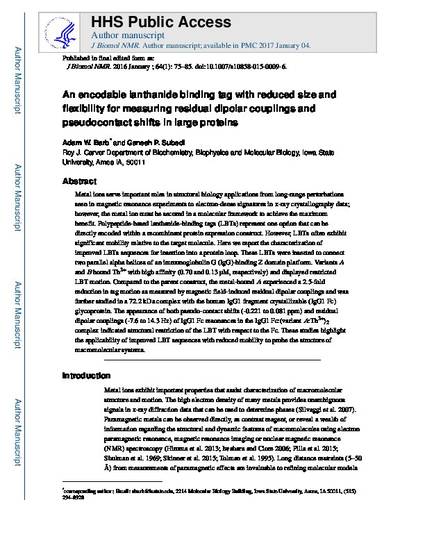
Metal ions serve important roles in structural biology applications from long-range perturbations seen in magnetic resonance experiments to electron-dense signatures in X-ray crystallography data; however, the metal ion must be secured in a molecular framework to achieve the maximum benefit. Polypeptide-based lanthanide-binding tags (LBTs) represent one option that can be directly encoded within a recombinant protein expression construct. However, LBTs often exhibit significant mobility relative to the target molecule. Here we report the characterization of improved LBTs sequences for insertion into a protein loop. These LBTs were inserted to connect two parallel alpha helices of an immunoglobulin G (IgG)-binding Z domain platform. Variants A and B bound Tb3+ with high affinity (0.70 and 0.13 μM, respectively) and displayed restricted LBT motion. Compared to the parent construct, the metal-bound A experienced a 2.5-fold reduction in tag motion as measured by magnetic field-induced residual dipolar couplings and was further studied in a 72.2 kDa complex with the human IgG1 fragment crystallizable (IgG1 Fc) glycoprotein. The appearance of both pseudo-contact shifts (−0.221 to 0.081 ppm) and residual dipolar couplings (−7.6 to 14.3 Hz) of IgG1 Fc resonances in the IgG1 Fc:(variant A:Tb3+)2 complex indicated structural restriction of the LBT with respect to the Fc. These studies highlight the applicability of improved LBT sequences with reduced mobility to probe the structure of macromolecular systems.
Available at: http://works.bepress.com/adam_barb/14/

This is a manuscript of an article published as Barb, Adam W., and Ganesh P. Subedi. "An encodable lanthanide binding tag with reduced size and flexibility for measuring residual dipolar couplings and pseudocontact shifts in large proteins." Journal of biomolecular NMR 64, no. 1 (2016): 75-85. doi: 10.1007/s10858-015-0009-6. Posted with permission.